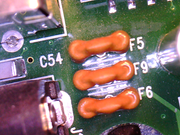howie
Junior Member
 
Posts: 88 
|
Post by howie on Aug 9, 2014 6:29:39 GMT -5
Always seem to run into wierd crap when I'm working on my own stuff. Todays cluster f**K is my own Crestron TPS-6000 wall mounted touch screen.
It has been working fine since installation. I needed to add a couple of buttons to the user interface. When done, I uploaded the new design to the screen as normal. At the end of the upload the touch screen rebooted as usual then died WTF. I did not have the time to look at it at that time so I unplugged the power/signal cable from it until I could look at it later. Over the weekend I pulled it from the wall so I could play detective. Couldn't find anything. I plugged it back in and it powered right up. So I put it back in place and it has worked fine for a couple of weeks. A couple of nights ago I had to power down the automation system for some rack maintainence. When I powered it back up, all the touch screens came back to life but that one. OK, back in detective mode cause it's dead. I think what I'm seeing is a surface mount PTC fuse that is not resetting. It is a small black device with one input and one output.
It has no name on it. There is a white line in the input side followed by a 33 over what looks like a A. I have 24 VDC going into it and nothing coming out.
I have 1,2 and 3 amp automotive type fuses here so I am going to try and jump it with a 1A first to see if it powers up. Wish me luck. These large Crestron
touch screens are wicked expensive and I don't wish to blow it.
|
|
|
|
Post by mastertech on Aug 9, 2014 9:10:14 GMT -5
If that does not work a picture would be helpful.
Based on your description it could also be a TVS in which case, open would be normal. Shorted would be failed.
|
|
howie
Junior Member
 
Posts: 88 
|
Post by howie on Aug 16, 2014 6:54:25 GMT -5
As you probably remember, I have a digital microscope in my repair area. So I took the board out of the touch screen and brought it to the microscope.
The part is labled on the board as "Z3" Zener diode? Funny that it is marked Z3 as I cannot locate Z1 and Z2. For some reason the software for my scope is not letting me take a snap shot so I'll have to describe the part. It is not a glass one. It is black plastic rectangle 2 lead. It has a white bar on one end and the only markings on it are 33 over A. (33 volts?) it is fed 24 vdc. I keep going back to this part because I can't find power anywhere after it. When I set my meter to diode test (BEEP), I get a quick beep then open in one direction and totally open in the other direction. I can't seem to match this up visually with anything I've seen searching on line.
|
|
|
|
Post by mastertech on Aug 16, 2014 9:18:57 GMT -5
Surface mount device markings can be very difficult to translate. There does not always seem to be a standard. So when you find something you think applies to your device you still can not be 100% sure it is correct. With that being said, this is what I found. But remember, I can not say for absolute it is what you have. But I did us multiple evidence points to this conclusion. Note page 3, column indicating device marking: Zener TVS.pdf (75.47 KB) |
|
|
|
Post by mastertech on Aug 16, 2014 9:32:13 GMT -5
Oh, and if this is correct then there is nothing wrong with it. Your part is fine.
|
|
howie
Junior Member
 
Posts: 88 
|
Post by howie on Feb 8, 2015 8:56:43 GMT -5
Here we go again Same model of touch screen but not the same one. Crestron TPS 6000 table top version. Every once and a while the touch screen would not respond to touch and come back to life. Un plug it, wait a minute and plug it back in and it would reboot and be normal. This time no such luck. It is not completely dead as the cooling fan on the optional RGB board is spinning, I hear that the audio is getting power and the ethernet port led flicker. There are a bunch of tan 3-leg fuses under the cover that I have to test. Why 3 legs and how to test them  |
|
|
|
Post by mastertech on Feb 8, 2015 19:25:21 GMT -5
This is the first i am seeing these on a pcb. There are 3 blade fuses for automotive. But essentially it is 2 fuses in 1. 1 is the supply voltage and the other 2 are circuit taps. All 3 pins should show short. If 1 side is blown you could just solder in a pigtail or pico fuse.
|
|